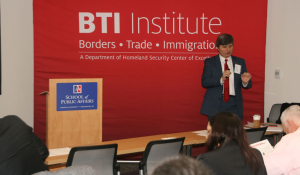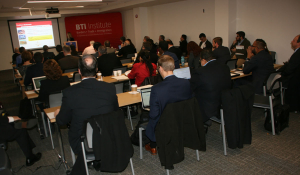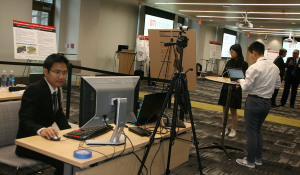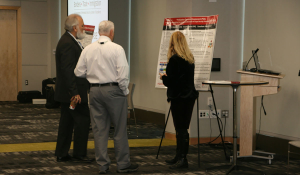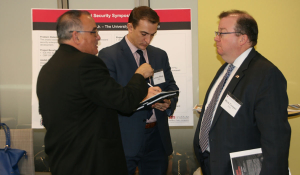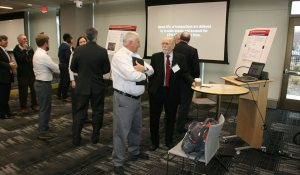The Borders, Trade, and Immigration Institute hosted the 2017 Meeting and Showcase Monday and Tuesday, December 4-5, 2017 at American University in Washington, D.C.
The Meeting and Showcase is an annual event in which principle investigators from BTI Institute partner institutions discuss and demonstrate their ongoing research projects. This year’s meeting focused on the transition of research to the Department of Homeland Security end-user.
Based on the needs of the end-user, the research conducted results in knowledge products that inform policy or technology that facilitates operations in the arenas of borders, trade and immigration, said Ioannis Kakadiaris, Ph.D., director of the BTI Institute.
The meeting was held on the first day and was an opportunity for the researchers and their DHS counterparts to discuss the transition process specifically tailored to the research being conducted. Several members of DHS were present including members from the U.S. Customs and Border Patrol and DHS Science and Technology division.
“It is important to work closely with your champions to focus research towards meeting the intended users’ needs,” said Matt Clark, director, Office of University Programs, DHS S&T.
The members of the DHS community that gave presentations focused on technology transfer, in addition to Clark, were
- Theo Gemelas, program manager for OUP, DHS S&T,
- Matt Coats, program manager for OUP, DHS S&T,
- MK Tribbie, oversight executive, DHS, and
- Milton Slade, Industry Liaison, CBP.
The researchers that presented were
- Kakadiaris, Image and Video Person Identification in an Operational Environment,
- Benjamin Melamed, Ph.D., Rutgers University, Modeling Methodology and Simulation of Port-of-Entry Systems,
- Maria Burns, University of Houston, Evaluating and Predicting the Operational Effectiveness of Cargo Security Technologies,
- Larry Shi, Ph.D., UH, Secure and Transparent Cargo Supply Chain: Enabling Chain-of-Custody with Economical and Privacy Respecting Biometrics and Blockchain Technology
- David Leblang, Ph.D., University of Virginia, Modeling International Migrant Flows: Theory, Evidence and Forecasts,
- Dennis Egan, Ph.D., Rutgers University, Missed Detections: From Data to Actionable Estimates,
- Randy Capps, Ph.D., Migration Policy Institute, Central America’s Immigrant and Refugee Crisis: Limiting Unauthorized Migration through the Alliance for Prosperity and Reintegration Efforts,
- Eric Hershberg, Ph.D., American University, The Impact of Central American Child and Family Migration on U.S. Communities,
- Gary Hale, Voir Dire International, LLC, Uncovering Human Smuggling Patterns from Guatemala to the U.S.,
- Bojan Cukic, Ph.D., University of North Carolina – Charlotte, A Systematic Process for Vulnerability Assessment of Biometric Systems at Borders,
- Victor Manjarrez, University of Texas El Paso, Homeland Security Symposium Series, and
- Shishir Shah, Ph.D., UH, Security Technologies Kitchen.
The second day consisted of poster displays and technology demonstrations that honed in on the methodologies and outcomes of the current research.
All presentations and posters can be found at https://bti.egr.uh.edu/research.
The BTI Institute is a Department of Homeland Security Center of Excellence led by the University of Houston. The BTI Institute conducts research and provides educational materials to enhance the nation’s ability to secure our borders, facilitate legitimate trade and travel, and ensure the integrity of our immigration policies. There are fifteen total partner institutions within the institute including academic, non-profit, think-tank, and industry organizations.
To find out more about the institute, the researchers, or partners, go to https://bti.egr.uh.edu.
